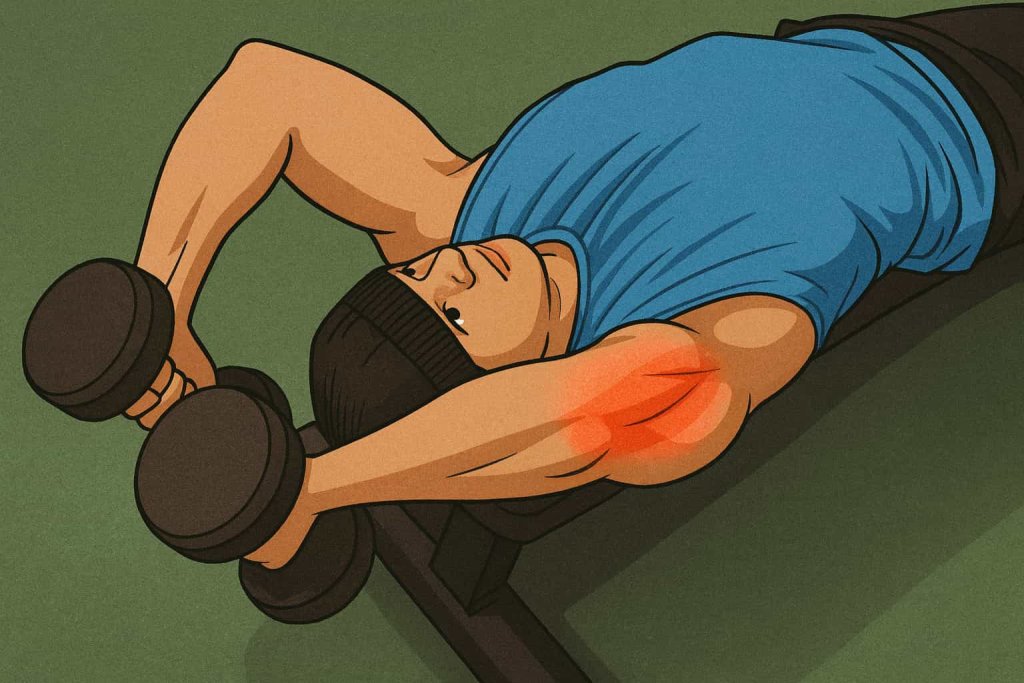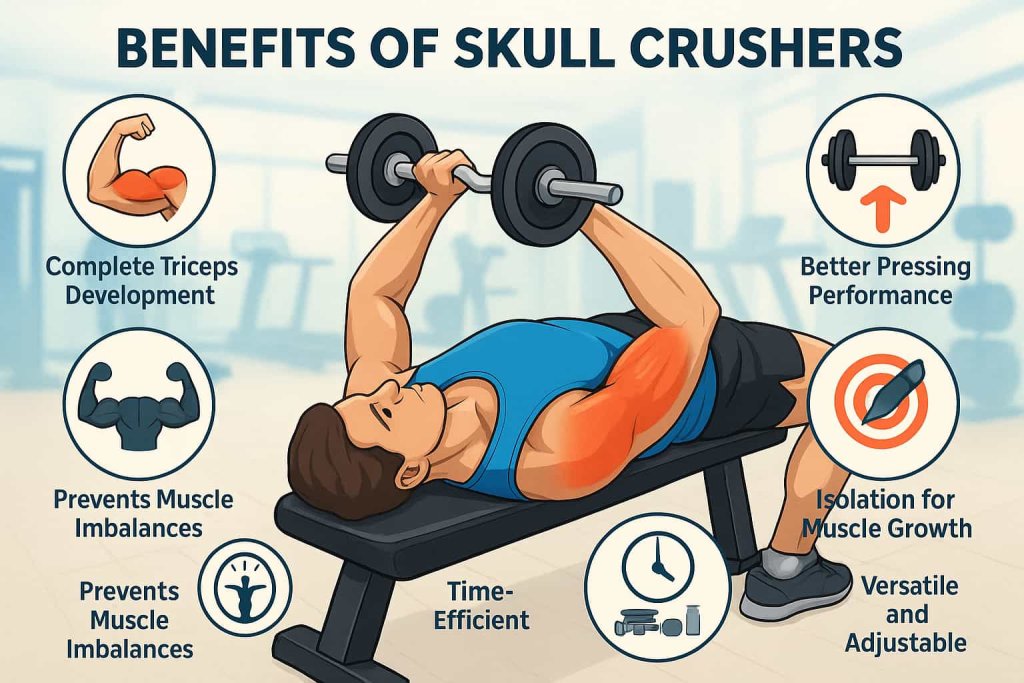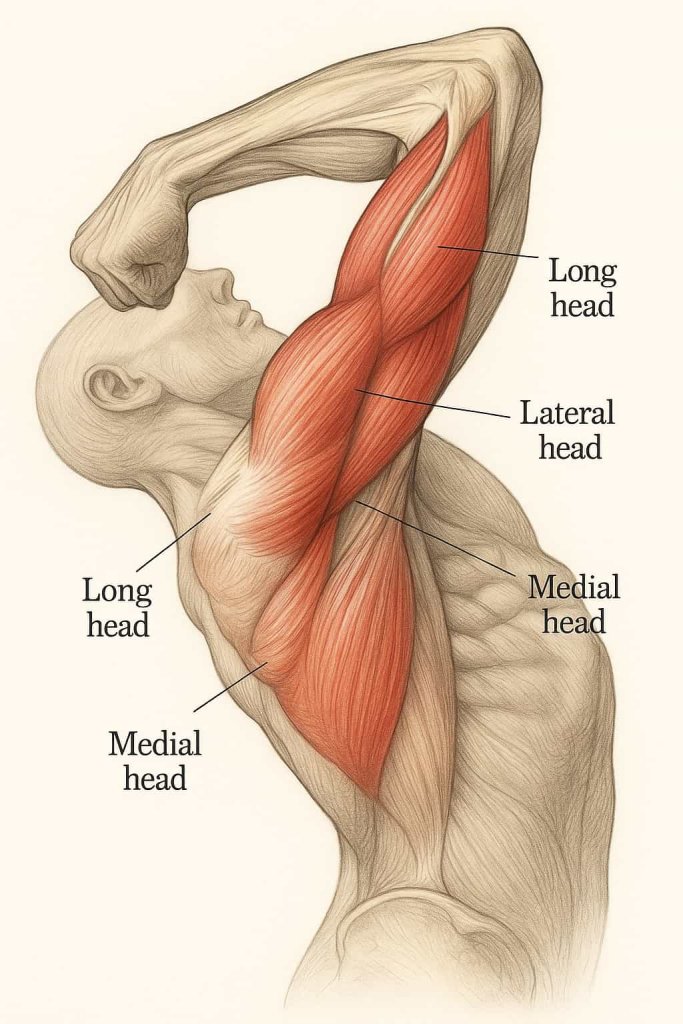Skull crushers are one of the best triceps exercises for building muscle, strength, and arm definition. They isolate all three heads of the triceps for targeted growth and stronger pressing performance. Understanding proper form, key variations, and common mistakes ensures you get the most from this exercise while staying injury-free.

In this complete guide, you’ll learn exactly how to do skull crushers, which muscles they work, why they’re so effective, the best variations for any level, what mistakes to avoid, safe alternatives, and top trainer tips.
Key steps: Start with the right weight, master your setup, focus on elbow control, and progress safely.
Why Do You Need Skull Crushers in Your Workout? (Benefits)
Skull crushers are essential for anyone serious about building strong, defined triceps and boosting upper body strength. Here’s why you should include skull crushers in your routine:

- Complete Triceps Development: Skull crushers target all three heads of the triceps (long, lateral, and medial), which most other triceps exercises can’t do as effectively. This leads to fuller, more balanced arm growth.
- Better Pressing Performance: Strong triceps are crucial for pressing movements like bench press, push-ups, and overhead press. Skull crushers improve your “lockout” strength, helping you push more weight safely.
- Isolation for Muscle Growth: They allow you to focus solely on the triceps without much help from other muscles, leading to greater muscle activation and better muscle-building results.
- Versatile and Adjustable: You can do skull crushers with different equipment (barbell, EZ-bar, dumbbells, cables) and at different angles, making them easy to fit into any program.
- Prevents Muscle Imbalances: Training the triceps thoroughly helps prevent upper arm imbalances, which can reduce your risk of injury in other lifts.
- Time-Efficient: High muscle activation in a single movement.
How to Do Skull Crushers With Proper Form
Step-by-Step Instructions
- Setup: Lie flat on a weight bench, head near the end, feet planted for stability. Hold an EZ-bar, barbell, or two dumbbells overhead, arms straight and wrists neutral.
- Grip: Hands shoulder-width apart (EZ-bar is easier on wrists; dumbbells allow neutral grip).
- Lowering the Weight: Keeping upper arms stationary and elbows pointed up, bend only at the elbows. Slowly lower the bar/dumbbells toward your forehead (for safety, you can lower slightly behind the head).
- Range of Motion: Descend until your forearms are just past parallel to the floor, or until you feel a strong stretch in your triceps.
- Lifting Back Up: Press the weight back up by extending only your elbows, focusing on squeezing your triceps. Avoid locking out forcefully at the top.
- Repetitions: Complete 8–12 controlled reps for muscle growth, or 6–8 for strength.
Trainer Tip: Keep elbows tucked and directly above shoulders. Avoid letting them flare outward or move forward/backward during the rep.
Safety Note: Always use a spotter for heavy barbell versions. Start light to perfect your form.
Muscles Worked by Skull Crushers

- Primary: Triceps brachii (long head, lateral head, medial head)
- Secondary: Anconeus (assists elbow extension), forearms (grip)
- Stabilizers: Shoulders (anterior deltoid), upper back (for position)
Why these matter: Strong, developed triceps are vital for arm size, athletic performance, and all pressing motions (bench press, push-up, dips). Skull crushers emphasize the long head, which is hard to hit with basic pushdowns.
Common Mistakes and How to Fix Them
| Mistake | Why It’s a Problem | How to Fix It |
|---|---|---|
| Elbows flare outward | Shifts load to shoulders, less triceps | Keep elbows tucked and close together |
| Shoulders/upper arms moving | Reduces triceps activation | Upper arms stationary, only elbows bend |
| Too much weight | Poor form, high injury risk | Use a weight you can control for 8–12 reps |
| Lowering to the nose/face | Safety risk, less triceps stretch | Lower to forehead or slightly behind head |
| Dropping weight too quickly | Joint strain, poor muscle tension | Lower with control, 2–3 seconds down |
| Locking out elbows forcefully | Elbow pain and injury | Stop just before full lockout |
Pro Tip: If you feel elbow or wrist pain, switch to an EZ-bar or dumbbells, or try the cable variation.
Popular Skull Crusher Variations: Complete Guide
1. EZ-Bar Skull Crusher
Why It’s Popular:
The EZ-bar skull crusher is considered the most wrist-friendly variation. The angled grip of the EZ-bar reduces stress on the wrists and elbows, making it easier for most lifters to perform the movement comfortably.
How to Do It:
- Lie flat on a bench, feet planted.
- Grip the EZ-bar with hands slightly inside shoulder width, palms facing in.
- Start with arms fully extended above the chest.
- Lower the bar toward your forehead, keeping upper arms fixed.
- Press back up, extending elbows but not locking out.
Benefits:
- Ergonomic grip minimizes joint strain.
- Allows you to use moderate to heavy loads.
- Excellent for building size and strength in all three triceps heads.
Trainer Tip:
Avoid letting your elbows flare out. Keep them tucked for maximal triceps activation.
2. Dumbbell Skull Crusher
Why It’s Popular:
With dumbbells, each arm works independently. This corrects muscle imbalances and offers a natural, neutral grip, which many find easier on the elbows and wrists.
How to Do It:
- Lie on a bench with a dumbbell in each hand.
- Start with arms extended, palms facing in.
- Lower the dumbbells beside your head, keeping upper arms still.
- Press back up in a controlled motion.
Benefits:
- Unilateral training—each side must work equally.
- Greater range of motion for a deeper stretch.
- Suitable for those with wrist or elbow issues.
Trainer Tip:
Go lighter than you would with a bar—stability is harder, and control is key.
3. Barbell Skull Crusher
Why It’s Popular:
Barbells allow you to load the most weight, making them ideal for strength gains. However, the straight bar puts more strain on the wrists, so strict form is crucial.
How to Do It:
- Lie on a bench, grip the barbell with hands shoulder-width apart.
- Lower the bar to your forehead, upper arms stationary.
- Extend elbows to return to the starting position.
Benefits:
- Maximal loading potential for muscle growth.
- Builds all three heads of the triceps.
Trainer Tip:
If you feel wrist discomfort, consider switching to the EZ-bar or dumbbells.
4. Incline Skull Crusher
Why It’s Popular:
Performing skull crushers on a bench set at 30–45 degrees increases the stretch on the long head of the triceps, which is crucial for full triceps development.
How to Do It:
- Set the bench to a 30–45° incline.
- Lie back with weights (bar, dumbbells, or EZ-bar).
- Lower weight behind your head (not to the forehead).
- Squeeze triceps to press back up.
Benefits:
- Enhanced stretch activates the long head.
- Useful for maximizing triceps length and mass.
Trainer Tip:
Keep core engaged and avoid overarching your lower back.
5. Decline Skull Crusher
Why It’s Popular:
Using a slight decline bench targets the lateral head of the triceps more directly, adding variety and helping develop that outer “horseshoe” look.
How to Do It:
- Set a decline bench to 15–30°.
- Lie back and secure your feet.
- Lower the weight to your forehead or just behind.
- Extend to the top.
Benefits:
- Emphasizes lateral (outer) triceps head.
- Unique angle can spark new growth.
Trainer Tip:
Use a spotter or lighter weights at first; balance is more challenging.
6. Cable Skull Crusher
Why It’s Popular:
Cables provide constant tension throughout the movement. This makes them ideal for high-rep finishers or when you want to avoid joint strain at the bottom.
How to Do It:
- Set a rope or bar attachment to the low pulley.
- Lie on a bench or the floor, grip the attachment.
- Extend arms up, elbows stationary.
- Lower behind head or to forehead, then press back up.
Benefits:
- Smooth resistance protects joints.
- Easy to adjust weight between sets.
- Excellent for controlled negatives and pump work.
Trainer Tip:
Don’t rush—use slow, controlled reps to maximize time under tension.
7. Floor Skull Crusher
Why It’s Popular:
Doing skull crushers on the floor limits the range of motion, making it a safer option for beginners and those with elbow discomfort.
How to Do It:
- Lie on the floor, knees bent.
- Perform skull crushers with dumbbells or an EZ-bar.
- Lower the weight until your triceps or elbows touch the ground, then press up.
Benefits:
- Protects the elbows by stopping the range just before joint stress.
- Good starting point for new lifters or those rehabbing injuries.
Trainer Tip:
Still keep tension on the triceps—don’t rest fully on the ground between reps.
Trainer’s Note: Smart Programming
Rotate Variations:
Switch between these skull crusher variations every 4–6 weeks. This keeps training fresh, prevents plateaus, and reduces overuse injuries—helping you build bigger, stronger triceps safely and efficiently.
Listen to Your Joints:
If any variation causes discomfort, swap it out for another or reduce weight until you find what works best for your body.
Quick Table: Skull Crusher Variations at a Glance
| Variation | Best For | Equipment | Unique Benefit |
|---|---|---|---|
| EZ-Bar Skull Crusher | Most lifters, joint comfort | EZ-Bar | Wrist-friendly, moderate-heavy loads |
| Dumbbell | Unilateral, deeper stretch | Dumbbells | Fixes imbalances, natural grip |
| Barbell | Maximum strength/mass | Barbell | Heavy loading, overall triceps mass |
| Incline | Long head emphasis | Any (bar/dumbbell) | Full stretch, upper triceps |
| Decline | Lateral head focus | Any (bar/dumbbell) | Outer “horseshoe” triceps |
| Cable | Constant tension, pump sets | Cable machine | Smooth resistance, joint-friendly |
| Floor | Beginners, elbow rehab | DB/EZ-Bar/Barbell | Safe range of motion, elbow comfort |
Skull Crushers vs. Other Triceps Exercises
Skull crushers vs. Triceps Pushdowns:
Skull crushers activate all three triceps heads, especially the long head. Pushdowns are joint-friendly and easier for beginners.
Skull crushers vs. Overhead Extensions:
Both target the long head. Overhead extensions stretch it even more but can stress the shoulders.
Skull crushers vs. Close-Grip Bench Press:
Close-grip is compound (works chest, shoulders, triceps), better for strength. Skull crushers are more focused, perfect for isolation work.
Alternatives to Skull Crushers
- Triceps Rope Pushdown (Cable): Easy on elbows, high tension throughout the rep.
- Overhead Dumbbell Extension: Great for stretching the long head.
- Close-Grip Bench Press: Adds chest/shoulder involvement; great for strength.
- Triceps Kickback: Lighter, very safe, and isolates triceps well.
- Diamond Push-Ups: Bodyweight option for high activation with no equipment.
Who Should (and Should NOT) Do Skull Crushers
Great for:
- Intermediate/advanced lifters wanting bigger, stronger arms.
- Anyone seeking more triceps lockout strength for bench, overhead press, or dips.
- Bodybuilders, athletes, and general fitness enthusiasts.
Caution:
- Not recommended for those with existing elbow or shoulder injuries.
- Beginners should master pushdowns or kickbacks before progressing.
- If you have poor shoulder mobility, start with cable variations or use lighter weights.
Trainer Tips for Safe & Effective Skull Crushers
- Warm Up Thoroughly: Include elbow and shoulder mobility drills.
- Form First: Always use a manageable weight—perfect reps are more important than heavy loads.
- Wrist Position: If wrists hurt, use a neutral grip or an EZ-bar.
- Control the Descent: Lower the weight slowly for max muscle engagement and joint safety.
- Progress Gradually: Add weight in small increments (2.5–5 lbs at a time).
- Use a Spotter: For heavy sets, especially with barbells.
- Mix Variations: Rotate equipment and grip for full development and long-term joint health.
- Recovery: Allow at least 48 hours before your next triceps session.
Sample Sets, Reps & Programming
- Muscle Growth (Hypertrophy): 3–4 sets of 8–12 reps
- Strength: 4–5 sets of 5–8 reps (use barbell/EZ-bar)
- Endurance/Finisher: 2–3 sets of 15–20 reps (dumbbells or cables)
- Frequency: 1–2x per week, minimum 48 hours rest between triceps workouts
Frequently Asked Questions (FAQ)
Q: Are skull crushers safe for everyone?
A: They are safe with good form and moderate weight. Avoid if you have elbow or shoulder pain.
Q: What is the best equipment for skull crushers?
A: EZ-bar and dumbbells are most wrist-friendly. Cables are best for high reps or joint issues.
Q: Should I lock my elbows at the top?
A: No. Stop just short of lockout for max tension and elbow safety.
Q: Can beginners do skull crushers?
A: Beginners should start with pushdowns, kickbacks, or cable skull crushers to build strength before moving to free-weight skull crushers.
Q: How do I add skull crushers to my routine?
A: Place them after compound pressing exercises or as a triceps finisher in your push day or upper body workout.
Conclusion
Skull crushers are a proven, science-backed exercise for triceps growth, strength, and arm definition. When done with proper form, they deliver unmatched results for athletes, bodybuilders, and anyone wanting bigger, stronger arms. Always prioritize quality reps, use joint-friendly equipment, and progress gradually. If you’re ready to upgrade your arm workouts, add skull crushers to your next session!
